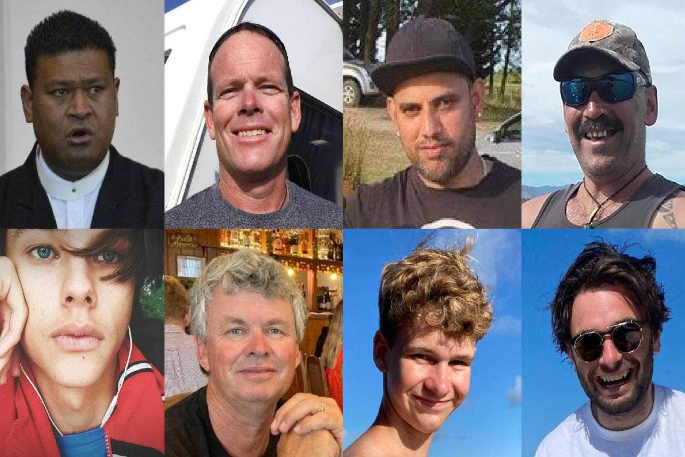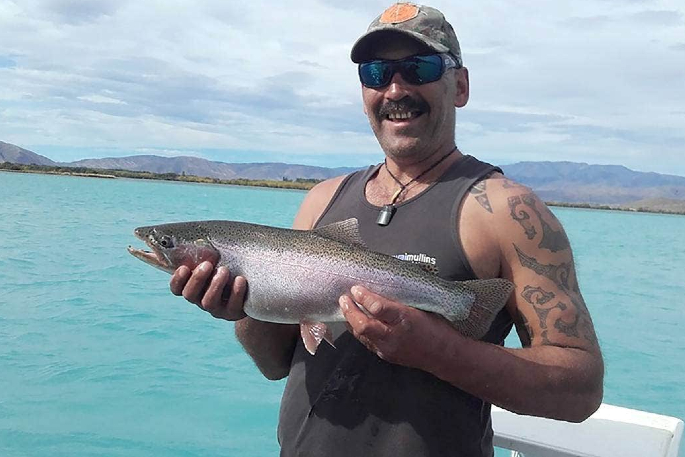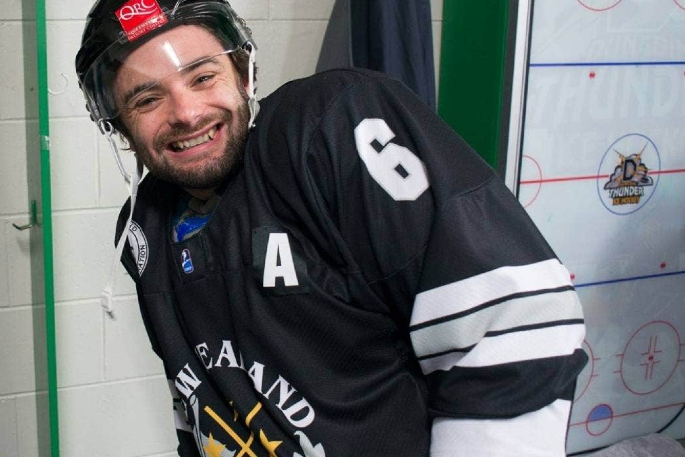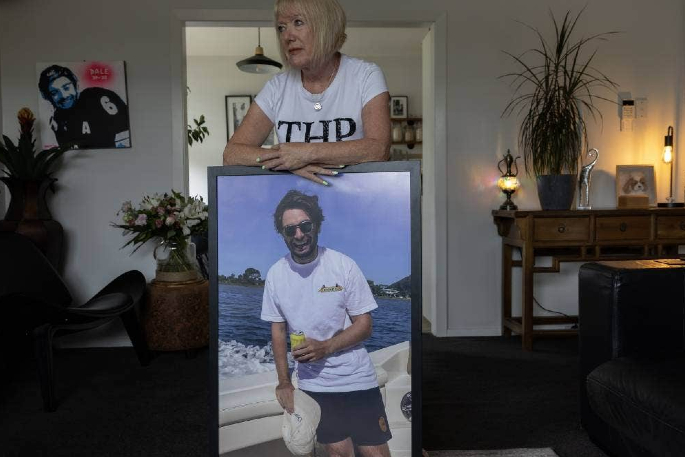Lynette Harrop told her only son not to tell her when he was going surfing.
She feared the ocean, and only wanted to hear from him when he'd emerged safe from the water and was on his way home.
But on December 17, after Dale Harrop, 33, went for a surf with a group of friends at Muriwai Beach, on Auckland's wild west coast, the call to say he was all right never came.
Instead, two police officers showed up at his mother's Christchurch home that evening, a week before Christmas, and told her he'd drowned.
'When [the officers] said it, I just walked away saying, ‘No.' I didn't want to believe it,” she says.
Harrop, a competent swimmer and one of the country's greatest ever ice hockey players, was the seventh person to die in a water-related incident in New Zealand this summer.
Since then, dozens of others have perished. They include divers, people fishing from rocks, and others who've got into difficulty while out boating or swimming in rivers or at beaches. Some have died trying to save others.

From left, top line: Lionati Fotofili, Steve Taylor, Varun Chand, Peter Nichol. From left, bottom line: Cameron Cumming, Ian Cruickshank, Samuel Cruickshank and Dale Harrop. Photo: Stuff.
While the way in which they've succumbed to the water varies, all but five of the 33 victims have at least one thing in common: They're men. (A woman, three children and a 15-year-old boy are the other victims.)
For example, shearer Peter Nichol, 57, a father of five, was taking a break from free diving for kaimoana for a friend's tangi when he was knocked from a rock by a wave in Bluff Harbour on December 10, and died.
Leroy Kaaho, 48, also known as Linkin Kisling, drowned while trying to rescue his 10-year-old son, who had got into difficulty while swimming in Lake Wakatipu near Glenorchy on January 13.
Friends Saurin Nayakumar Patel, 28, Anshul Shah, 31, and Apurva Modi were swimming in the shallows at Piha Beach, west of Auckland, on January 21, when they were overwhelmed by the waves, and sucked underwater. Only Modi survived.
Peter Nichol died in a free diving incident in Bluff Harbour on December 10. Photo: Supplied/Stuff.
While the summer's toll is lagging slightly behind the same time last year (it was 38 on January 25, 2022), the frustrated chief executive of Water Safety New Zealand, Daniel Gerrard, believes that's only because stormy weather that plagued much of the North Island in the first few weeks of this year kept people away from the water.
His belief is supported by the numbers. So far this month, at least 17 people have died in what are deemed to be preventable water-related incidents. All but one of those deaths have happened since January 13 (about the time rain gave way to sunshine), and 15 happened in nine days.
Last year's summer toll closed at 47, the highest recorded in nearly four decades.
'We've got five weeks to go. If people's behaviour doesn't dramatically change over the next few weeks we could be looking at the worst summer this century … the trend is heading up dramatically,” Gerrard says.
New Zealand's drowning problem is more than a disturbing statistic.Video: Stuff.
'It just shows that all this investment, time and energy and resources of all these organisations … is not making the impact that's necessary. We need to have a rethink.”
Gerrard says in recent years tens of millions of dollars has been poured into 'bottom of the cliff” services, such as Coast Guard and Surf Lifesaving, which are now 'very well-resourced”, but not enough has been invested into life-long education and preventative programmes to effect change in people's behaviour around water.
He's highly critical of men, particularly those aged 40 and over, who accounted for three-quarters of the 93 people (this is a provisional Water Safety New Zealand statistic) who drowned in New Zealand last year.
'If we were to only invest in one group, that would be the bunch we'd be targeting. It's this macho image, it's this she'll be right [attitude], it's this belief that I've survived this long I must know what I'm up to.”

Water Safety New Zealand chief executive Daniel Gerrard. Photo: Supplied.
The reality is, as people get older they're not as physically able as they once were, and also develop underlying health conditions, both of which can lead to them getting into trouble in the water, he says.
The summer holiday period is also particularly fraught, because people, including tourists and migrants, are often swimming in places they've never visited before.
'Everyone needs to take time to look at the conditions, and whether they match their ability. Let's all enjoy our amazing and beautiful waters, but if in doubt stay out.”
The impact of this summer's death toll spreads far and wide, with friends and family grieving the loss of loved ones across the country.
But the number of fatalities would be much higher if lifeguards weren't on patrol at beaches.
The latest statistics from Surf Lifesaving New Zealand show they saved 551 lives in the last six months of 2022, a 23% increase on the same period the previous year.
The organisation's chief executive, Paul Dalton, agrees that more money needs to be spent on education and preventative programmes, but that shouldn't come at the expense of resources available to those patrolling the country's beaches.
'There's a need for that last line of defence. There's always going to be this little tip of the pyramid where people are swimming outside of areas where there are lifeguards, or after hours, and in those situations that's where the education needs to kick in, so people are making better decisions. There's definitely room to improve in that area. We need to be doing something different to get the message through to them.”
By the numbers
Water Safety New Zealand's provisional 2022 drowning statistics:
-
There were 93 preventable drownings in NZ waters in 2022
-
79 of these deaths were males
-
23 were over the age of 65
-
23 were at beaches and 21 were in rivers
-
32 of those who died were NZ European, while 22 were Māori
-
75 happened in the North Island and 18 in the South Island
Surf Lifesaving Northern Region chief executive Matt Williams has a blunt message for people visiting the country's beaches for the remainder of the summer.
'We need to remember the ocean is not safe, and it isn't your friend. Swim between the flags.
'Ask yourself: would you be comfortable saving your children in the water if something went wrong? Drowning is a terrible way to lose someone.”
Surfers should talk to other surfers and lifeguards at the beach, and spend time studying the conditions, before entering the water.
'The beach is a volatile environment and no two hours are the same. That's why it's important that the public work with lifeguards and swim between the flags so that [lifeguards] are able to respond to life-threatening incidents like [the one involving] Dale and his friends, as opposed to chasing up members of the public who aren't following the rules. Surf lifesaving is not resourced to underwrite a lack of commonsense on the coastline.”

Dale Harrop, 33, was a competent swimmer, and loved surfing. Photo: Supplied.
Dale Harrop last spoke to his mother on December 16.
They talked on the phone about who he'd been assigned for Secret Santa, and he sent her photos of his new office at the Auckland branch of international development company Arup, where he worked as an urban designer.
The former Lincoln University student didn't mention he was planning on heading for a surf the next day, likely the last trip to the beach he'd be able to squeeze in before he flew south to Christchurch the following week to celebrate Christmas with family and friends.
He was well aware his mother worried about him going surfing, and knew not to mention it.
Lynette Harrop rarely visited the beach growing up, and lacked confidence in the water. But the same couldn't be said for her two children, who'd both been taught how to swim.
'I feared for Dale, but that was my fear, not his,” she says. 'He used to say, ‘Mum, don't worry about it – it's all fine,' as they do at 33 years old.”
Dale Harrop was a talented sportsman, best known as a veteran ice hockey player, having represented New Zealand's national men's team, the Ice Blacks, at 10 world championships since he debuted for the side in 2007.

Dale Harrop was on eof the country's greatest ever ice hockey players. NZIHF/Supplied.
He'd only been surfing for about 18 months, but had caught the bug and regularly ventured to beaches in the greater Auckland region.
About 3pm on December 17, Harrop and three mates donned their wetsuits and waded into the water at Muriwai's main beach, a popular surf break he'd visited a number of times previously.
It was overcast, and the surf was messy. But from the shore it looked like they'd be able to have fun catching waves in the white water. Any concerns they had were allayed by the fact members of the local surf school were out in force.
But it wasn't a typical day at Muriwai Beach. The sea conditions were from the northwest, the opposite to what is considered normal, and they exacerbated a strong current feeding a rip near rocks at the southern end of the beach.
Harrop and his friends started out surfing just to the left of the flags (surfers are encouraged to stay outside the flags so as not to endanger swimmers). But the conditions were more challenging than they expected and they were quickly pushed several hundred metres down the beach from where they'd entered the water.
Experienced lifeguards who were on duty realised the group were in trouble and rushed to their aid.

Muriwai Beach is one of Auckland's most popular surf spots. Photo: Jason Dorday/Stuff.
One of the surfers was able to paddle to shore, while two others were rescued with the help of a jetski.
But Harrop was unaccounted for.
As his friends sat on the beach waiting for news of his whereabouts, the lifeguards came across his surfboard floating in the waves.
Then, a short time later, they found his lifeless body in the water. The leash he'd used to attach the board to himself wasn't broken, suggesting he'd removed it himself, perhaps in an effort to try and scale rocks and get to safety. (An expert says a surfer caught in a rip should always stay with their board and ride it out until help arrives.)
Efforts to revive him back on shore were unsuccessful.
More than a month later, Lynette Harrop is still struggling to come to grips with the death of her son, who's remembered as a popular, easygoing guy, with an infectious smile and a great sense of humour. He'd been selected in the Ice Blacks team to travel to Turkey in April, and planned to move to Europe at the end of the year.
'Sometimes I sit here, and I actually don't believe it. It's just horrible to know he's not going to be around any more.”
News of all the other drownings is a constant reminder of what happened to her son.
'I can't watch TV any more – seeing all these people [dying] is terrible. I just feel for those other families who are going through what I'm going through.
'Dale wasn't a risk-taker. It's a horrible accident. You've just got to be so careful because it can happen to anyone."
- Blair Ensor and Melanie Earley/Stuff.



1 comment
Overit
Posted on 28-01-2023 09:43 | By overit
So many primary schools without swimming pools now, kids not learning to swim. I know its only partially the problem.
Leave a Comment
You must be logged in to make a comment.